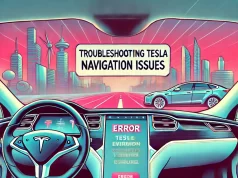Tesla Autopilot is a driver assistance system that can perform various tasks such as steering, accelerating, braking, changing lanes, and parking.
However, it is not a fully self-driving system and requires the driver to pay attention and be ready to take over at any time.
Tesla warns that improper usage of Autopilot can lead to suspension of the feature, also known as Autopilot jail.
Why Tesla Got Autopilot Disabled?
There are two main reasons why Autopilot can be disabled for the rest of the trip:
#1. Forced Autopilot Disengagements
These occur when the driver ignores the warnings to apply torque to the steering wheel or to take over the control of the vehicle.
Autopilot will disengage and display a message that says “Autosteer Unavailable for the Rest of This Drive”.
If this happens five times, the driver will lose access to Autopilot until the next software update.
#2. Speed Limit Exceedance
This happens when the driver overrides the speed set by Autopilot with the accelerator pedal and goes above the system limit, which is 80 mph for vision-only cars and 90 mph for radar-equipped cars.
Autopilot will disengage and display a message that says “Autosteer Unavailable for the Rest of This Drive”.
This will not affect the access to Autopilot for future trips unless it happens five times in a row.
What to do if Autopilot is disabled?
If Autopilot is disabled for the rest of the trip, the driver can try the following steps to restore it:
#1. Pull over and put the car in park
This will reset the Autopilot system and allow the driver to resume using it unless they have reached the five disengagement limit.
#2. Soft reboot the car
This will restart the touchscreen and the Autopilot computer, which may fix some glitches or errors that caused the disengagement.
To soft reboot the car, put it in park, press and hold the brake pedal, press and hold both scroll wheels on the steering wheel for 10 seconds, wait for the screen to go black, release the brake pedal and the scroll wheels, and wait for the screen to reboot.
#3. Hard reboot the car
This will restart the entire car, including the battery and the powertrain, which may resolve more serious issues that affect the Autopilot performance.
To hard reboot the car, put it in park, press and hold the brake pedal, press and hold both scroll wheels and both steering column buttons for 10 seconds, wait for the screen to go black, release the brake pedal and the buttons, and wait for the screen to reboot.
#4. Contact Tesla support
If none of the above steps work, or if the driver has lost access to Autopilot permanently, they should contact Tesla support and report the issue.
Tesla may be able to diagnose the problem remotely or schedule a service appointment to fix it.
How to avoid Autopilot jail?
The best way to avoid Autopilot jail is to use the feature responsibly and follow the instructions and warnings displayed on the screen.
Some tips to prevent Autopilot disengagements are:
#1. Keep your hands on the steering wheel and apply slight torque to it
This will let the system know that you are paying attention and ready to take over. You can also use the scroll wheels or the turn signal stalk to acknowledge the nags.
#2. Do not exceed the speed limit or the system limit
Autopilot will adjust the speed according to the traffic and the road conditions, but you can also set a speed limit offset in the settings.
Do not override the speed with the accelerator pedal, especially if you are approaching the system limit of 80 or 90 mph.
#3. Be aware of the road and the surroundings
Autopilot may not perform well in some situations, such as poor weather, low visibility, sharp curves, construction zones, or unmarked lanes.
Be ready to intervene and take over the control of the vehicle if needed.
Conclusion
Tesla Autopilot is a great feature that can enhance the driving experience and safety, but it is not a substitute for human drivers.
It is important to use it correctly and follow the rules and guidelines provided by Tesla.
If Autopilot is disabled for the rest of the trip, the driver can try to restore it by pulling over, rebooting the car, or contacting Tesla support.
If Autopilot is suspended permanently, the driver will have to wait for the next software update to regain access to it.




